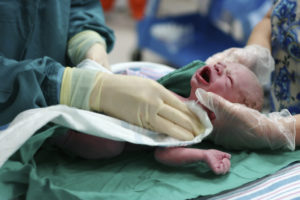Birth Injury Caused by Asphyxiation, Strangulation, or Respiratory Distress
A baby’s developing brain requires oxygen at all times in order for the brain cells to fully develop and keep various biological processes running. Any hypoxic event can lead to malformation of brain, which can then develop into cerebral palsy.

Birth Asphyxiation and Cerebral Palsy
Fetal asphyxia is one of the most-common causes of a child being born with cerebral palsy. This can be defined as the interruption of blood flow (oxygen) to the baby’s brain during gestation or labor, often due to some kind of constriction or blockage, placental abruption, or serious maternal infection.
The importance of monitoring fetal distress signals during labor cannot be understated, and medical professionals know this all too well. While hypoxic events can occur naturally or unexpectedly, a doctor or nurse’s failure to identify and mitigate harm to the child could rise to the level of medical malpractice in some situations.
Fetal Asphyxia During Labor
There are several different ways that an infant may suffer brain damage due to asphyxia. One all too common scenario involves the child being strangulated during labor or delivery. This can occur due to the child being in an odd position during labor (e.g., breech birth) or because the umbilical cord becomes wrapped around their neck, cutting off their oxygen.
Asphyxia or oxygen deprivation doesn’t only affect the brain cells; it can cause hypoglycemia, intracranial hemorrhages, and respiratory distress syndrome in newborn children as well. Doctors are required to closely monitor a baby’s heartbeat during delivery in order to identify any signs of fetal distress and take immediate action. Oftentimes when the child is showing signs of distress, the best course of action is an emergency C-section delivery.
Issues With the Umbilical Cord
The umbilical cord provides oxygen, blood, and nutrients to the baby while in the womb. Any issue with the umbilical cord (such as an umbilical cord prolapse) could put the child at risk of serious harm.
A nuchal cord refers to the coiling of the umbilical cord around the infant’s neck. This can be as a single coil, but in some cases, the cord coils itself around the neck numerous times. Nuchal cord is said to happen in anywhere between 10 to 30% of all births, and it is more-common in males than females. Not all cases of nuchal cord lead to strangulation or asphyxia, but your doctor should closely monitor any such issues.
Nuchal cord often occurs spontaneously, but some conditions raise the risk of its occurrence. For example, your child is more-likely to experience a nuchal cord if you are having twins or triplets, if the fetus is larger than what is considered a normal weight, if they are underdeveloped, if they are born in breech position, or if there is an excessive amount of amniotic fluid.
Constriction of the umbilical cord is said to cause 19% percent of all fetal deaths, and frequently occurs during the second trimester. While this knot usually tends to remain loose during pregnancy, it can easily tighten during labor or delivery, constricting blood and oxygen flow to the brain.
Hypoxic Ischemic Encephalopathy
Hypoxic ischemic encephalopathy (HIE) is the medical term for a brain injury that occurs due to a lack of oxygen. This can either be caused by blood flow restriction or low oxygen levels in a child’s blood.
If your child had to be resuscitated shortly after delivery or experienced seizures after birth, it’s reasonable to suspect HIE. Hypoxic ischemic encephalopathy can sometimes be treated by way of a brain cooling procedure to minimize any further brain damage, but such treatment is not always immediately available or effective.
If you suspect that your child’s development of cerebral palsy was caused by malpractice and would like to discuss your situation with a cerebral palsy lawyer, call 1-855-833-3707.
